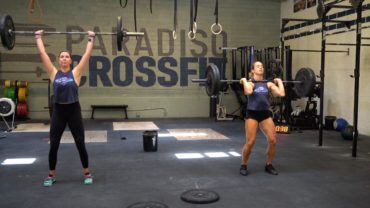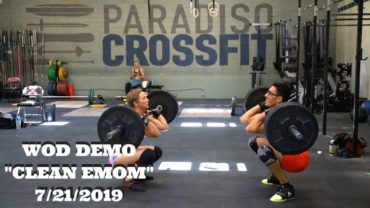Post 14.3 Protect Your Back
Saturday March 15, 2014
Bring a friend day! Beginners welcome! Today is your day to show them what crossfit is all about!
Pre-hab:
Bird dogs 2×15
Side Planks 2×45″
Handstand holds 2×45″
Warm up:
Junk Yard Dog x5
-then 2 rds- (PVC –>BB)
7 Push ups (3 sec up/3 sec down)
6 BTN Press
5 BTN Push Press
Strength:
5 x 3 Push Press
Notes: Focus on good lockout and keeping your torso upright and weight in your heels as you dip down.
Conditioning:
AMRAP 20 minutes:
Partner 1: 12 Situps
Partner 2: 12 KB SDHP
Partner 1: 12 Jumping Squats
Partner 2: 6 Burpees
Partner 1: 200M Run
*Partner 1 will start while Partner 2 rests. After Partner 1 finishes the situps, Parter 2 will begin the KB SDHP. One person will always be working while one is resting.
*After Partner 1 finishes his/her 200m run, partner 2 will start their situps. Partners will be doing what the other person did before. Keep rotating for 20 min.
Cool Down:
2′ Plank Hold
Swan Stretch
Foam Roll T-spine x2′
One of the few pictures ever captured of this beast
Deadlifts, deadlifts and some more deadlifts. Not exactly what your lumbar spine wants to hear, particularly because it is the most susceptible to a muscle strain or potential disc injury with a heavy long duration flexion based workout. Ideally you will want to perform each rep with a perfectly neutral L-spine, but when fatigue and adrenaline kicks in, I’m probably going to be seeing a lot of rounded spines. The problem with this is that the much weaker Lumbar spine is asked to assist the much stronger hamstrings and glutes as they begin to breakdown at the point of failure. This becomes a huge problem. For most of you, the delayed onset muscle soreness will be your only complaint. But for others, the damage may be much more severe. Localized pain, decreased range of motion and sciatica may rear their nasty little heads. As your lumbar spine loses its lordosis and starts to round, there are excessive compressive forces placed on the anterior disc causing posterior aspect of the disc to potentially bulge or protrude into the nerves surrounding the spinal cord. This is obviously the worst case scenario but the older atheletes beware, the younger guys may be able to get away without pain or injury now, but back injuries are rarely from macrotraumatic events, rather they are from small injuries over time that leads to “the straw that breaks the camel’s back”. As we age, the strength of the annular fibers surrounding the gelatinous nucleus decreases, along with decreased height of the disc from dehydration over time. Many younger atheletes may actually have disc bulges and not even realize it because they don’t have pain, but that can definitely change after a workout like 14.3
In order to prevent yourself from getting injured after the workout, I suggest that you spend alot of time in spine extension. Not only did you just spend 8 min repeatedly flexing your spine with heavy loads, but you also probably sat behind a computer all day in a flexed position, then got in your car and drove to the gym in a flexed position, and after the workout is over you will get into your car and drive home in a flexed position, then you will sit on your couch and have a few cold ones in a flexed position. Have I made my point yet? Its time to give your spine some extension. Simply standing up is only putting your spine in a neutral position, it needs to be more extended.
My suggestions: after the wod, go home and lie flat on your stomach for 10-15 min. Simply doing this will help to take some pressure off the posterior annulus, stretch your hip flexors and abdominal muscles. Feel free to throw a bag of ice on your lumbar spine as you lie there. In addition, the cobra stretch and couch stretch (standing or kneeling) are also fantastic ways to realign your spine and put it back into a stable position, in order to begin to offset the negative effects of all those DL’s. I also have this little list of basic exercises that are great to perform the day after such a flexion biased workout. Stay healthy and stay moving.
Here is an interesting graph that illustrates the % of pressure placed on your discs in various standing vs. seated positions. You can see how sitting in a slouched position places nearly 2x as much pressure on your back vs a standing position
As always feel free to email me with any questions you may have: steve.sudell@gmail.com















